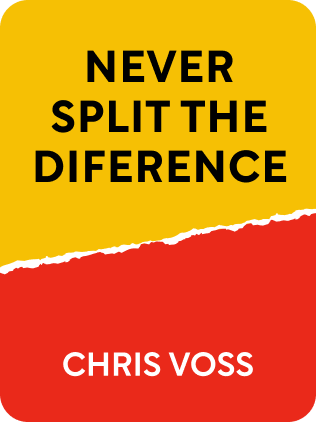

This article is an excerpt from the Shortform book guide to "Never Split the Difference" by Chris Voss and Tahl Raz. Shortform has the world's best summaries and analyses of books you should be reading.
Like this article? Sign up for a free trial here .
What is the Ackerman Model? How is it different from the traditional, old negotiating schools of thought?
The Ackerman Model is a bargaining approach that is based on the offer-counter-offer system. Unlike the traditional “split the difference” approach, it uses the tapering principle to bring down the amount in a bargaining negotiation.
Keep reading for more about the Ackerman Model of negotiation and some examples of how it works in practice.
The Ackerman Model for Negotiation
The Ackerman Model is a good alternative to traditional, old-school negotiating schools of thought. It’s an offer-counteroffer system, but it crucially avoids the counterproductive “split the difference” approach that dissatisfies both parties.
First, set a target price. This should be ambitious, but reasonable. You don’t want to negotiate with yourself and set your target price too high (if you’re the buyer), but you also don’t want to set it so low that your counterpart would never agree to it. Doing some research beforehand will help you set your goal.
Next, you establish your first offer at 65 percent of your target price. If your target price is $100,000, you first ask for $65,000. This establishes an extreme anchor and throws your counterpart off their heels.
- Interestingly, it also makes your own loss aversion instinct work to your advantage. By starting with a low offer, you’ll start thinking of anything higher than that as a “loss,” which you’ll work hard to avoid. Of course, you’re still below your target price at this point, so it’s really still a “win” for you.
- In addition, your extreme anchor can force your counterpart to reveal their own price limit. If they balk and say something like, “I couldn’t possibly sell for anything less than $75,000,” that means you’ve forced them to reveal their price floor.
Get your counterpart to negotiate against themselves. When they throw you an unacceptable counteroffer, use a calibrated question like “How can I pay the price you’re asking for this?” Get them to think about how they can solve your problems.
- You can also label their emotions or motivations to get them to say “no.” A good example of this would be, “It seems like you’d rather not sell this item at all than work with me on this.” When they inevitably deny that this is the case, you’ve shifted the negotiating environment: you’ve gotten them to say that they do want to make a sale with you.
Next in the Ackerman Model, you plan your counteroffers. For these, use three increases—but each time, you reduce the size of the increase.
- For example, you first counter with a number that’s 85 percent of your target price (a 20 percentage point jump). Then, you increase it to 95 percent of your target price (only a 10 percentage point jump this time). If they’re still not accepting this, then finally you meet them at your full target price (a mere 5 percentage point jump).
- All of this activates your counterpart’s inclination toward reciprocity. They’ll be inclined to match your raises with concessions of their own.
There’s also great power in the decreasing increments of your offer increases. They fool your counterpart into thinking that they’re squeezing you for every last penny. This makes them feel like they’re in control and that they’re earning hard-won concessions from you. Of course, you know that you’re still well below your target price.
Next, use a precise, non-round figure for your final number to give it added weight and credibility. We mentioned this earlier when we discussed framing effects, but it bears repeating: $101,321.94 sounds like a much firmer, non-negotiable number than $100,000. This will signal to your counterpart that this number is the product of a great deal of calculation and analysis on your part and that, therefore, it can’t be negotiated.
Lasty, throw in a non-monetary item along with your final offer to signal that you’re truly at your limit. By pivoting to something other than money, you’re sending a message to your counterpart that the monetary portion of the negotiation is over and done with.
Negotiating Rent: The Model in Practice
Let’s consider how the Ackerman Model can be applied to a real-world negotiation scenario.
A student who was paying $1,850/month for an apartment was presented with an unacceptable offer by his landlord: the rent would go up to $2,100/month if he wanted to renew.
How did the student respond? First, he did his research on rents for comparable buildings in the area and set his target price at $1,830: less than he was already paying!
When the student met with the landlord, he emphasized how much he enjoyed living in the building and that he wished to renew, but that there were comparable buildings in the area that offered lower rents. He asked his first calibrated question: “How am I supposed to pay $250 extra per month?”
The landlord, however, didn’t budge and pointed out that the building could be charging even more than they were asking the student. Then, the student responded with his first offer: “I understand that you have a great building and could be charging a premium, but it’s simply outside my price range. Would $1,730 be reasonable?”
The landlord didn’t accept this figure, which the student expected. But he wisely avoided getting pulled into a tit-for-tat. Instead, he asked another calibrated question: “How much does it cost to refurbish an apartment after a tenant leaves?”
The landlord responded that it could cost up to $2,000 just to clean and renovate the apartment to get it ready for a new tenant. The student knew he had an opening: he pointed out that not reaching an agreement meant that the landlord could face both the refurbishing costs and the foregone income from rent. Now, the landlord was thinking in terms of loss aversion.
The landlord then came back with an offer of $1,950. This time, the student used a label to say “no” without actually saying it, by telling the landlord, “That offer is very generous, but I still can’t make that number work. It seems like you’d prefer to roll the dice and risk leaving it unrented than work this out with me.”
The landlord gave the student the “no” he was looking for by saying, “No, that’s not the case at all, we want to work out a renewal with you, we just can’t offer below market.”
At last, the student pulled out his final, non-round number. He told the landlord, “All right, I see you’re being reasonable and working hard to address my concerns. The most I can do is $1,829.”
The landlord was impressed with the number. “You seem very precise about that figure,” he observed. “I think we can make that number work.” And that’s how this student used the Ackerman Model to turn a rent increase into a rent cut.

———End of Preview———
Like what you just read? Read the rest of the world's best book summary and analysis of Chris Voss and Tahl Raz's "Never Split the Difference" at Shortform .
Here's what you'll find in our full Never Split the Difference summary :
- Lessons learned from years as an FBI hostage negotiator
- Why negotiation is about emotional appeals, not rational ones
- The 5 methods for tactical empathy, which gets you what you want by focusing on the other person's feelings






